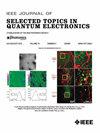Re-Configurable, Photonic-Wire-Bonded Integrated Circuit for Degenerate and Non-Degenerate Photon Pair Generation
IF 5.1
2区 工程技术
Q1 ENGINEERING, ELECTRICAL & ELECTRONIC
IEEE Journal of Selected Topics in Quantum Electronics
Pub Date : 2025-03-15
DOI:10.1109/JSTQE.2025.3570453
引用次数: 0
Abstract
A fundamental challenge associated with parametric sources is the fact that the conversion efficiency from the pump field to the quantum field is typically quite low, such that the residual pump light must be effectively filtered from the channels that carry the quantum photonic states. Here, we present an integrated silicon photonic circuit that can perform parametric generation, pump rejection, and wavelength de-multiplexing (WDM) of quantum correlated (both degenerate and non-degenerate) photon pairs at telecommunication wavelengths. The circuit utilizes an all-pass micro-ring resonator (MRR) as the photon pair source, and three separate 4-port contra-directional couplers (CDCs) as filters. One of the three filters acts as a pump reject filter, and the other two as WDM filters. The WDM filters have two different center wavelengths and two heaters attached to them for tuning. The chip is connected on opposite sides to two fiber arrays using photonic wire bonds to facilitate alignment-free operation using four distinct filter configurations for generating both degenerate and non-degenerate photon pairs. The best coincidence-to-accidental ratio (CAR) for the non-degenerate pairs is 1070 at an estimated pair generation rate (PGR) of 2.1 kHz at the output of the MRR. The maximum CAR for the degenerate photon pairs is 348 at an estimated on-chip PGR of 6.8 kHz.用于简并和非简并光子对生成的可重构光子线键集成电路
与参数光源相关的一个基本挑战是,从泵浦场到量子场的转换效率通常很低,因此残余的泵浦光必须有效地从携带量子光子态的通道中滤除。在这里,我们提出了一个集成的硅光子电路,它可以在电信波长上执行量子相关(包括简并和非简并)光子对的参数产生,泵抑制和波长解复用(WDM)。该电路采用全通微环谐振器(MRR)作为光子对源,三个独立的4端口反向耦合器(cdc)作为滤波器。三个滤波器中的一个作为泵抑制滤波器,另外两个作为波分复用滤波器。WDM滤波器有两个不同的中心波长和两个加热器连接到它们用于调谐。该芯片使用光子线键连接到两个光纤阵列的相对两侧,以促进使用四种不同的滤波器配置来产生简并和非简并光子对的无对准操作。在MRR输出的估计对产生率(PGR)为2.1 kHz时,非简并对的最佳偶合比(CAR)为1070。简并光子对的最大CAR为348,估计片上PGR为6.8 kHz。
本文章由计算机程序翻译,如有差异,请以英文原文为准。
求助全文
约1分钟内获得全文
求助全文
来源期刊

IEEE Journal of Selected Topics in Quantum Electronics
工程技术-工程:电子与电气
CiteScore
10.60
自引率
2.00%
发文量
212
审稿时长
3 months
期刊介绍:
Papers published in the IEEE Journal of Selected Topics in Quantum Electronics fall within the broad field of science and technology of quantum electronics of a device, subsystem, or system-oriented nature. Each issue is devoted to a specific topic within this broad spectrum. Announcements of the topical areas planned for future issues, along with deadlines for receipt of manuscripts, are published in this Journal and in the IEEE Journal of Quantum Electronics. Generally, the scope of manuscripts appropriate to this Journal is the same as that for the IEEE Journal of Quantum Electronics. Manuscripts are published that report original theoretical and/or experimental research results that advance the scientific and technological base of quantum electronics devices, systems, or applications. The Journal is dedicated toward publishing research results that advance the state of the art or add to the understanding of the generation, amplification, modulation, detection, waveguiding, or propagation characteristics of coherent electromagnetic radiation having sub-millimeter and shorter wavelengths. In order to be suitable for publication in this Journal, the content of manuscripts concerned with subject-related research must have a potential impact on advancing the technological base of quantum electronic devices, systems, and/or applications. Potential authors of subject-related research have the responsibility of pointing out this potential impact. System-oriented manuscripts must be concerned with systems that perform a function previously unavailable or that outperform previously established systems that did not use quantum electronic components or concepts. Tutorial and review papers are by invitation only.
 求助内容:
求助内容: 应助结果提醒方式:
应助结果提醒方式:


